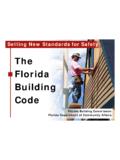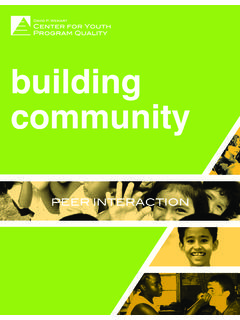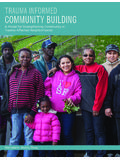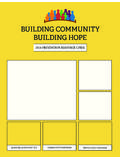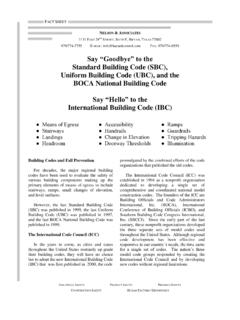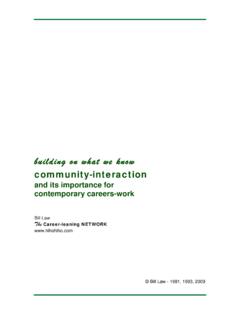Transcription of A A Practical Practical Guide Guide toto Creating Creating ...
1 A Practical Guide toA Practical Guide toA Practical Guide toA Practical Guide toA Practical Guide toCreating a SustainableCreating a SustainableCreating a SustainableCreating a SustainableCreating a SustainableCommunity BuildingCommunity BuildingCommunity BuildingCommunity BuildingCommunity building - February 2005 -Front cover photographsFront cover photographsFront cover photographsFront cover photographsFront cover photographsTop - Ardross Village Hall, Easter Ross; designed by David Somerville Architect David SomervilleCentre - Sgoil na Coille, Sunart, Lochaber Sunart Oakwoods InitiativeBottom - Garbh Eilean wildlife hide, Loch Sunart, Lochaber Sunart Oakwoods InitiativeNetwork 21 is a partnership of the Highland Wellbeing Alliance involving publicbodies from the Highland community Planning Partnership (The HighlandCouncil, Scottish Natural Heritage, Highlands and Islands Enterprise and NHSH ighland) and the voluntary sector (Voluntary Groups East Sutherland andVoluntary Action Lochaber).
2 Between 2002 and 2005, the Network 21project received grant support from the Scottish Executive s Rural StrategicSupport 21 aims to: Encourage sustainability to be embedded in community developmentsupport in the Highlands Encourage community action on sustainable development Provide a range of support and advice on sustainable development Promote best practice on guidance was produced for Network 21 by Campbell Consulting (Highland)Ltd in association with David Somerville from the text may be re-produced for use by or on behalf ofcommunities, provided the source is every effort has been made to ensure the accuracy of the advice given,neither the Network 21 partnership nor its member organisations can acceptliability for loss or damage arising from the information pdf version of this guidance can be downloaded from the Highlands andIslands Enterprise website. Hard copies are available from:FEBRUARY 2005 Strengthening Communities, Highlands and Islands EnterpriseCowan House, Inverness Retail and Business Park, Inverness IV2 7 GFTel 01463 234 171 ContentsINTRODUCTION What this Guide covers1 What do we mean by a sustainable community building ?
3 2 Why incorporate sustainability into the design of a community building ?3 STAGE1:GETTING STARTED: THE building FEASIBILITY STUDY Getting organised4 How to find an architect/design team with sustainability credentials5 Developing the project brief and incorporating your sustainability requirements8 Site selection and best use8 Meeting essential planning requirements9 Indicative costs9 Funding issues10 STAGE 2:DEVELOPING YOUR PROPOSAL: THE SCHEME DESIGN STUDY Healthy and comfortable buildings12 Construction methods13 Energy system options14- Minimising energy use14- Choosing your energy source15 Use and specification of sustainable materials17 Minimising waste water and managing sewage18 Access for all and parking18 Planning consent and building control19 STAGE 3:CONSTRUCTION AND COMPLETION Preparation of tendering contract documents20 Tendering for building contractors20 Letting the contract20 On-site management20 Project hand-over, snagging and building maintenance issues20 Final completion21 WHERE TO GO FOR FURTHER INFORMATION22 EXAMPLES OF BEST PRACTICE IN SUSTAINABLE CONSTRUCTION26 PageSubject guidesThe series of numbered GUIDES below provides further information and pointers on subjects coveredin the main text, where each Guide is referenced where 1:Key considerations for sustainable community design and constructionGUIDE 2:WHO, WHAT & WHEN: An overview of Creating a community buildingGUIDE 3:Key issues in site selection and making the most of your siteGUIDE 4:Some construction approaches that you may come acrossGUIDE 5:Some sustainability issues to consider when specifying your building materialsGUIDE 6:Design checklist to minimise energy use and wastageGUIDE 7.
4 Renewable energy options appropriate for community buildingsGUIDE 8:Sustainability pointers for water, sewage and waste managementGUIDE 9:Design checklist for access for allGUIDE 10:Sustainability tick list for community buildingsGUIDE 11:Funding sources specifically for sustainability costsGUIDE 12:Network 21 sustainability checklistWhat this Guide coversThis Guide provides an overview forcommunity groups that wish to incorporatesustainability practice within their plans fora new or renovated community building . Itoutlines the main sustainability issues andchoices that you will come across, and haveto make decisions about, in the design andconstruction Guide is based on experience ofcommunities, professional developers andthe agencies. Whilst not aiming to be totallycomprehensive, it signposts communities toguidance and advice sources which can betailored to individual project and aware that sustainability is a vast subjectarea and an evolving specialism, and optionsavailable for communities are likely tochange.
5 The Guide is based on informationavailable at the time of writing andcircumstances may subsequently periodic updates to the Guide may bemade, it is the user s responsibility to applyinformation community construction project willrequire consultation with professionals,especially as every organisation has its ownquirks and special needs. The trick is onlydoing this when necessary and with enoughbackground knowledge so as to reduce thechargeable Guide does NOT cover the early andimportant stage of assessing communityneeds, Creating a community profile andestablishing an appropriate organisation tomanage the the reference section Where to go forfurther information, for other sources ofguidance on these Guide starts with an overview of thepurpose and principles of sustainableconstruction practice in the sections go on to illustrate howthese can be applied in the three mainstages of Creating a community building :Stage 1 Getting Started: theBuilding Feasibility StudyStage 2 Developing Your Proposal.
6 TheScheme Design StudyStage 3 Construction and CompletionThe Guide describes the steps you need toundertake at each stage, highlighting thesustainability issues and options to beaddressed and some of the choices that willface final section provides a series ofSubject Guides these are tools to help youin your decisions, including checklists, Practical action points and quick can be copied for reference use byyour project committee as the Sustainability Tick List ( Guide 10) isincluded as a Practical tool to help youmonitor your sustainability progress as youdesign your building . This is intended as aguide rather than an exact science to beused together with the team of buildingprofessionals that you are working elements listed may not be appropriateor feasible for your firstly, what do we mean by asustainable community building ?All buildings have an impact on thesustainability of their immediatesurroundings and the global environment. Inboth the design and construction process of abuilding there is a series of choices to bemade, each of which can result in a negativeor positive contribution to sustainability either immediately or in the longer termuse of the building .
7 A sustainable building isdesigned (most obviously) to minimise thenegative environmental impact of thebuilding, but equally importantly tomaximise positive social and economicimpacts including future management andcosts:Minimising Negative Environmental Impact by adopting design and construction methodsthat minimise adverse impacts on theenvironment and protect and enhance thediversity of nature. For example: reducing orminimising energy consumption and relatedCO2 production; careful selection ofmaterials used; minimising waste createdduring the design, construction and lifetimeof the Social Impact by providingbuildings that enhance the quality of life foreveryone living in the community , activelysupporting social inclusion. Buildings thatintegrate sustainability principles createbetter and healthier living and workingenvironments. They attract greater use byvoluntary and community groups which gainvalue and support from each buildings demonstrate andpromote good practice in both constructionand use, providing ideas for others to applyelsewhere.
8 They can also provideopportunities for therapeutic uses of thebuilding and the surrounding Economic Impact by designingand constructing buildings that are morecost-effective to run, have high qualityworking environments, which lead to greaterproductivity, and provide local employmentand development of skills in design,construction and use. Sustainable buildingsalso promote the use of local supply chainsand may influence job creation in theforestry, farming and recycling sectors bypromoting the use of renewable and, wherepossible, locally-sourced materials, timber products; natural orrecycled insulation 21 has produced a sustainabilitychecklist ( Guide 12) that itemises thecomponents of the three areas above andhow they can be applied to developmentprojects with broader objectives than acommunity construction incorporate sustainabilityinto the design of a communitybuilding?In Europe, approximately half our energy isused in buildings, the largest share of whichis for heating.
9 Global warming, drivenprimarily by CO2 emissions, requires achange in our current patterns of energygeneration and use. So working withbuildings provides an excellent opportunityto act to reduce CO2 emissions by planningfor high levels of energy efficiency in theirdesign, construction and stringent requirements arebeing introduced into building regulations,to contribute towards nationalenvironmental targets to lower CO2emissions. These set a minimum standardfor energy efficiency, however, whichcommunities should ideally aim to that are designed to exceed basicBuilding Regulation requirements can deliversignificant benefits to communities, becausethey:- Save on running costs through efficiencymeasures and use of renewable energysources. Maximise local economic impact duringconstruction, by sourcing materials andlabour locally. Reduce the negative environmentalimpact of construction, throughminimum site disturbance and waste. Promote best practice to other localdevelopers who may be building in thecommunity.
10 Support and encourage the developmentof products and systems with goodenvironmental credentials, which couldpotentially be produced in planning and design stage of a building isthe key time to identify which sustainabilityaspects will have the greatest impact, areachievable in your building , and how toincorporate them. Solutions will vary indifferent situations. This booklet providesstep by step notes on applying sustainabilitypractice to the building process, along withthe other vital considerations of communityneed, cost, space requirements, and buildingregulations. As a starting point, Guide 1gives a summary of the key sustainabilityissues to OrganisedPrior to thinking about building design, youneed to carry out preparatory work in thecommunity, including:- Identifying the community need andcreating a community profile Establishing a formal organisation tomanage the project Research on and study visits to examplesof sustainable community buildingsIdentifying the community need andcreating a community profileYour Local Enterprise Company (LEC) andCouncil of Voluntary Service (CVS) arerecommended as the first port of call inhelping to carry out an initial communityneeds exercise or assessing the businessplanning or financial viability of the will be able to Guide you on, andpossibly provide funding for, this earlyconsultation process.



